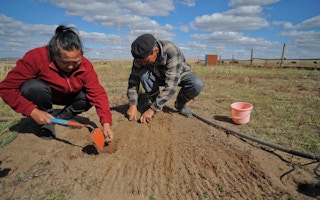As the world prepares for a pivotal climate conference in Paris this December, countries are offering their national plans to tackle a changing climate. These plans, known as intended nationally determined contributions (INDCs), contain details of what each country is prepared to do as part of a new global climate agreement. While the public focus is often on mitigation – how much countries are willing to reduce emissions, by when and with what degree of transparency – adaptation to the impacts of climate change demands the same level of attention. In fact, the last round of international climate talks in Lima invited parties to include adaptation in their INDCs.
To date, 11 countries — China, Ethiopia, Gabon, Kenya, Marshall Islands, Mexico, Monaco Morocco, Serbia, Singapore and South Korea — have included adaptation in their INDCs. The United States and European Union have submitted “undertakings in adaptation planning,” a formal submission outside the INDC process that was also invited in the Lima decision. This degree of attention to adaptation issues foreshadows what is likely to be an enhanced focus on adaptation in the Paris negotiations.
Flexibility, with common elements
“
For now, the inclusion of adaptation in almost half of the submitted INDCs shows that many countries are approaching adaptation with urgency.
Countries have a great deal of flexibility in the kind of adaptation information they share, and their rationales for including adaptation may differ. Some may wish to communicate advances in adaptation planning and action, highlight the vulnerability of important economic sectors or demonstrate their readiness for various forms of international support. Some may also wish to raise the general profile of adaptation action in order to encourage and support the idea of a long-term goal on adaptation in the international agreement.
Each country’s adaptation component is unique in form and content, but there are common threads. Most INDC adaptation plans:
-
Articulate a clear vision or goal: Most INDCs with an adaptation component contain language about what the country hopes to achieve in adaptation. The language varies, from Morocco’s broad vision that it aims to “preserve its territory and its civilization in the most appropriate manner,” to Ethiopia’s pledge “to ensure that adaptation to climate change is fully mainstreamed into development activities,” to Mexico’s specific measurable goals that include achieving zero percent deforestation by 2030.
-
Describe current and planned adaptation action: Many countries use INDCs to communicate existing plans and activities. China, for example, describes accelerating the implementation of its National Strategy for Climate Adaptation. Gabon’s INDC focus on coastal zone management is drawn from its National Adaptation Strategy. And while the main text of Singapore’s INDC contains scant details of adaptation action, an annex states, “Singapore started early to integrate long-term adaptation planning,” and then describes efforts underway in food security, infrastructure resilience, public health and other areas.
-
Outline adaptation needs and support: Many INDCs highlight needs for finance, technology and capacity building to achieve adaptation goals. South Korea and Mexico outline specific needs in capacity building. Morocco is explicit in its financial needs, expecting adaptation costs to rise from 9 percent of national expenditures to 15 percent, and indicating a need for international financial support. The United States and European Union describe the types of support they intend to provide to developing countries, and China indicates a commitment to strengthen ongoing cooperation with other developing countries. And while avoiding explicit mention of recouping costs, Serbia’s INDC contains a section that outlines the 5 billion Euros in loss and damage it experienced due to extreme weather from 2000-2015.
INDCs exhibit an important difference between adaptation and mitigation when it comes to support. On the mitigation side, several countries describe mitigation that can be achieved without international support and then describe additional action that can be taken with international support. So far, this kind of conditional action has not been described in the adaptation components of INDCs.
What’s next?
In the coming weeks, we expect to see more INDCs with adaptation components. Like the ones that have come before, we expect wide diversity in form and content.
Despite this diversity, the Lima decision mandates the UNFCCC Secretariat to assess the INDCs’ aggregate effect – a task that is clear and quantitative for mitigation, but will no doubt pose a number of conceptual challenges for adaptation, since adaptation needs and actions differ widely from place to place. That means we need a creative approach to synthesizing the adaptation information.
That synthesis will play an important role in establishing the context for broader discussions of adaptation in the lead-up to Paris, including discussions of a possible long-term global adaptation goal and the incremental process countries will put in place to achieve it.
For now, the inclusion of adaptation in almost half of the submitted INDCs shows that many countries are approaching adaptation with urgency. It also suggests adaptation will have a higher profile within the context of the Paris negotiations than it often has had in past negotiations.
Heather McGray is director, vulnerability and adaptation, World Resources Institute. This post is republished from WRI’s Insights blog.











